Through gentle gestures and inherited knowledge, caring for children’s Afro hair becomes a true ritual of love, memory, and identity. More than just a hair routine, this article offers essential tips to nourish, style, and celebrate the natural beauty of our little ones—while respecting their texture, their story… and their crown.
Inheriting the crown
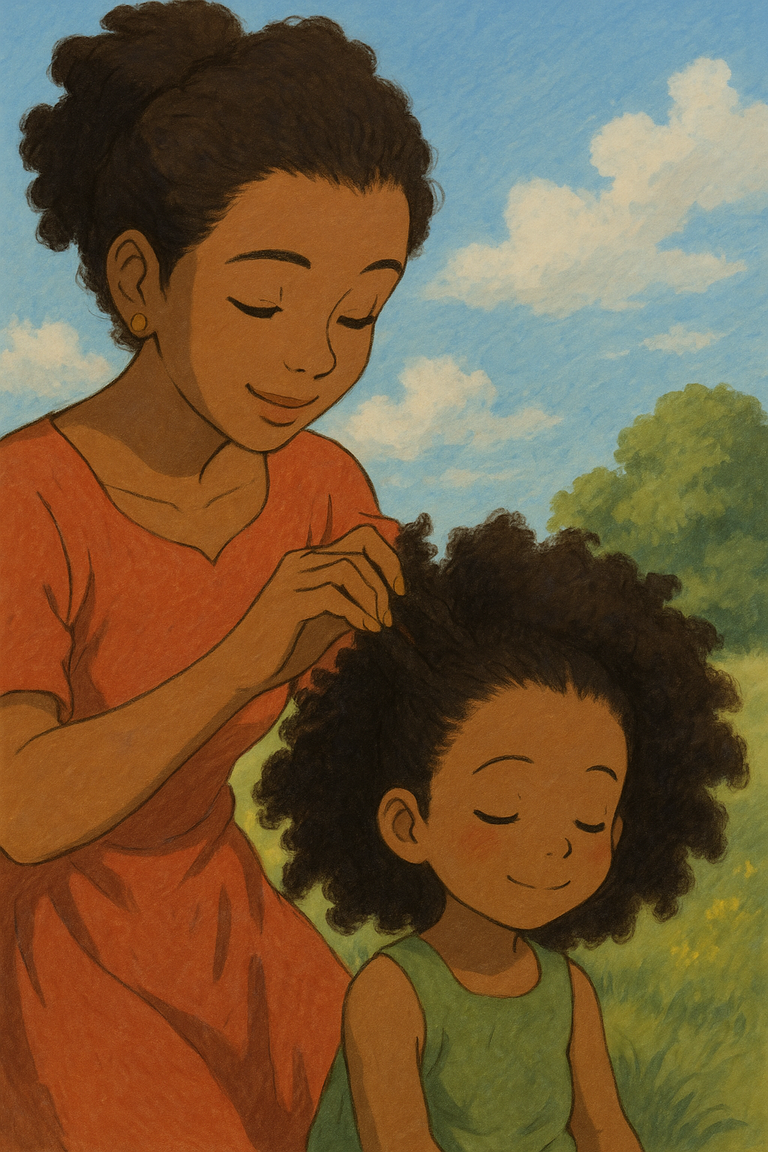
Our children’s Afro hair is more than just a texture or genetic trait. It is the continuation of a history, a continent, a dignity. And yet, how many children grow up thinking their curls need to be tamed rather than celebrated? This guide is an act of love. A tribute to the moms, dads, aunties, and grandmothers who braid each strand like shaping a future. To those who choose tenderness over pain, fingers over combs.
Understanding our children’s hair
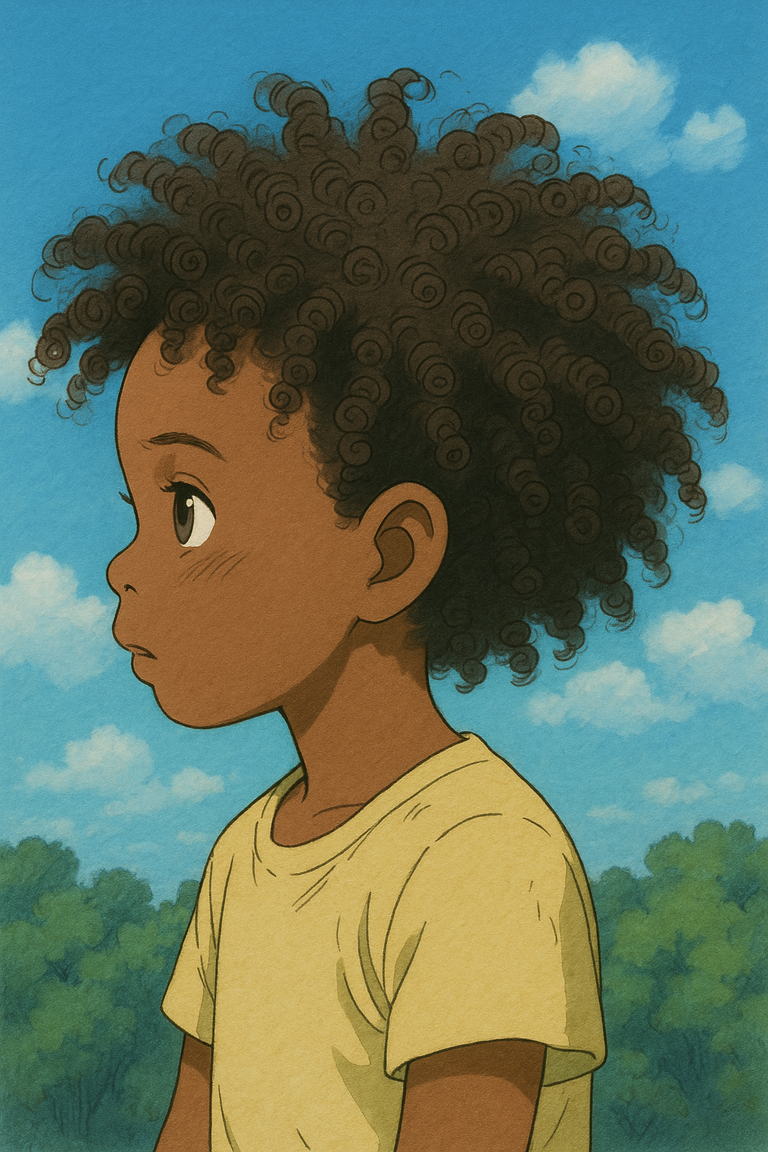
The unique structure of afro hair
From the very first months, our little ones’ hair already tells a story. One of spiral strands, often misunderstood, sometimes mistreated, but carrying ancestral memory. Unlike other hair types, Afro-textured hair has a coiled or zigzag shape, creating natural points of fragility at each bend.
In babies and young children, this fragility is heightened: their strands are finer, more porous, and break more easily. They are thirsty—literally. They need regular moisture and gentle care. Too much rubbing or pulling, and the hair snaps. And sometimes, along with it, a budding sense of self.
In today’s world—where curls are still often seen as flaws to be “managed”—understanding Afro hair early on is a foundation of self-recognition. It is rejecting imposed standards foreign to their scalp, and embracing the beauty of who they are, naturally.
Hence the need to unlearn automatic habits shaped for other textures. Afro hair is not “tamed”—it is heard, felt, and respected. We do not “treat” it—we honor it.
A soothed scalp, well-hydrated strands, and gentle care: this is where hair health begins. And this is also where self-esteem begins.
The Importance of the Scalp
We often talk about curls but rarely about the soil from which they grow. And yet, it all begins in the scalp. In children, this skin beneath the hair is even more sensitive than in adults—thin, fragile, still maturing, and quick to react to aggressions: harsh products, tight braids, friction from cotton pillowcases.
Neglecting the scalp is like planting a seed in dry soil. Nourishing the lengths without hydrating the base is like watering the leaves without touching the roots.
That’s why every hair care session should begin here. A gentle massage with warm vegetable oil (like sweet almond, jojoba, or grapeseed), just a few minutes a week, boosts blood circulation and encourages hair growth. More than that, it creates a sensory and emotional bond with the child: a loving ritual, far from pain and trauma.
Lastly, the scalp is a wellness indicator. Flakes? Probably too dry. Redness or itching? The product may not suit. A thinning patch? Time to loosen up those hairstyles. Tuning into the scalp is becoming the guardian of a living heritage.
The truth about shampoo (what no one tells you)
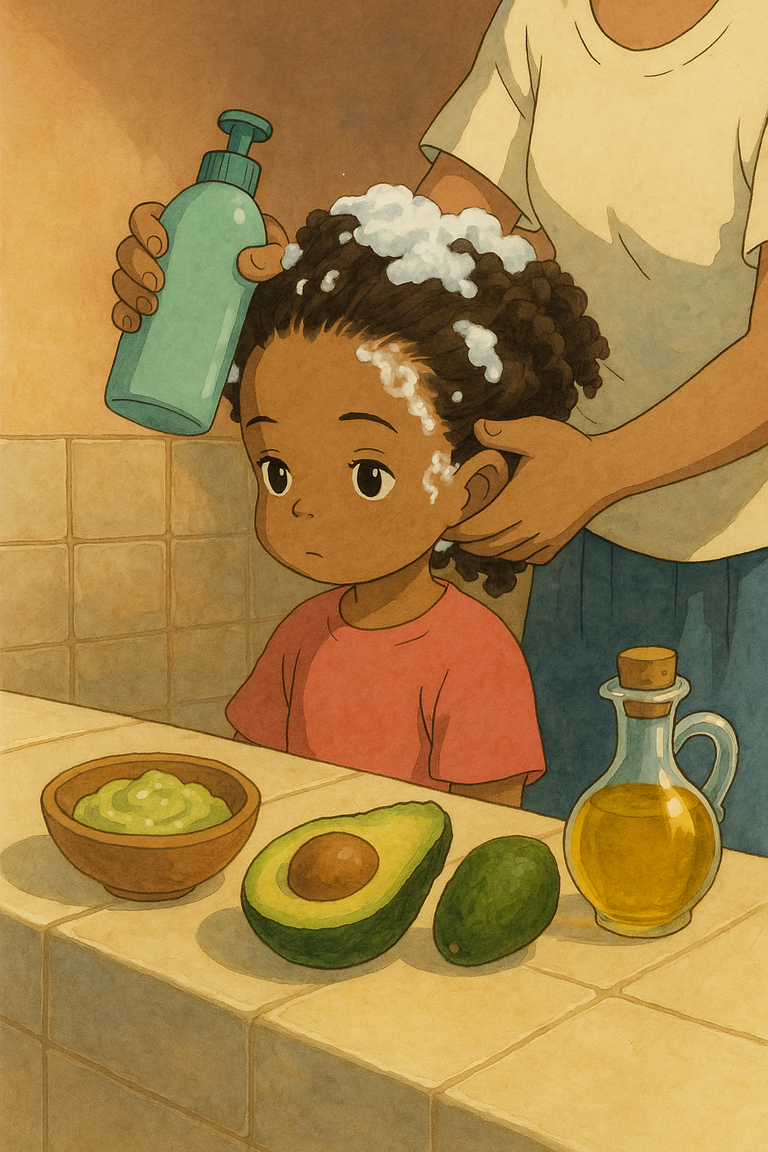
Less is more
Marketing taught us that cleanliness equals foam, that care means synthetic fragrance. But when it comes to children’s Afro hair, that logic falls apart. Too much washing weakens the hair. Too much stripping robs it of its natural protection: sebum. And kinky hair is already low in sebum, because the spiral shape prevents the oil from traveling down the strands.
For young children, washing too frequently leaves the scalp vulnerable—dryness, itching, breakage. That’s why we must rethink our habits. Two shampoos a week? Often too much. One is enough—especially if the child doesn’t sweat heavily or live in a dusty environment.
But the choice of shampoo matters. Avoid sulfates (like sodium laureth sulfate), parabens, and synthetic fragrances. Choose gentle cleansing bases from coconut or sugar, or better yet, explore natural recipes passed down from our grandmothers.
Simple homemade tip:
Mix warm water, shaved natural African black soap, and a few drops of lavender essential oil. Apply, massage gently, and rinse.
The magic of gentle conditioners
If shampoo cleanses, conditioner protects. Often overlooked in toddlers’ routines, it’s actually a vital repairing treatment. It seals cuticles opened during washing, eases detangling, and nourishes without weighing the hair down. It’s an invisible shield.
For Afro-textured hair, conditioner is not a luxury—it’s a gesture of love, a balm against the world’s aggressions. And again, simplicity is best: the younger the child, the purer the formula should be.
Avoid products with long lists of unreadable ingredients. Look for formulas rich in aloe vera, vegetable glycerin, oat milk, or sweet almond oil. You can also make your own moisturizing blends with plain yogurt, honey, and a dash of olive oil.
DIY mask from age 2:
- ½ ripe avocado
- 1 tbsp olive oil
- 1 tsp honey
- Blend until smooth. Apply after shampoo, leave on for 10 minutes under a cap, then rinse with warm water.
This mask is a blessing for dry or rough hair. It brings softness, shine, and above all: it teaches your child that their hair is precious and deserves tender, sacred care.
The art of drying
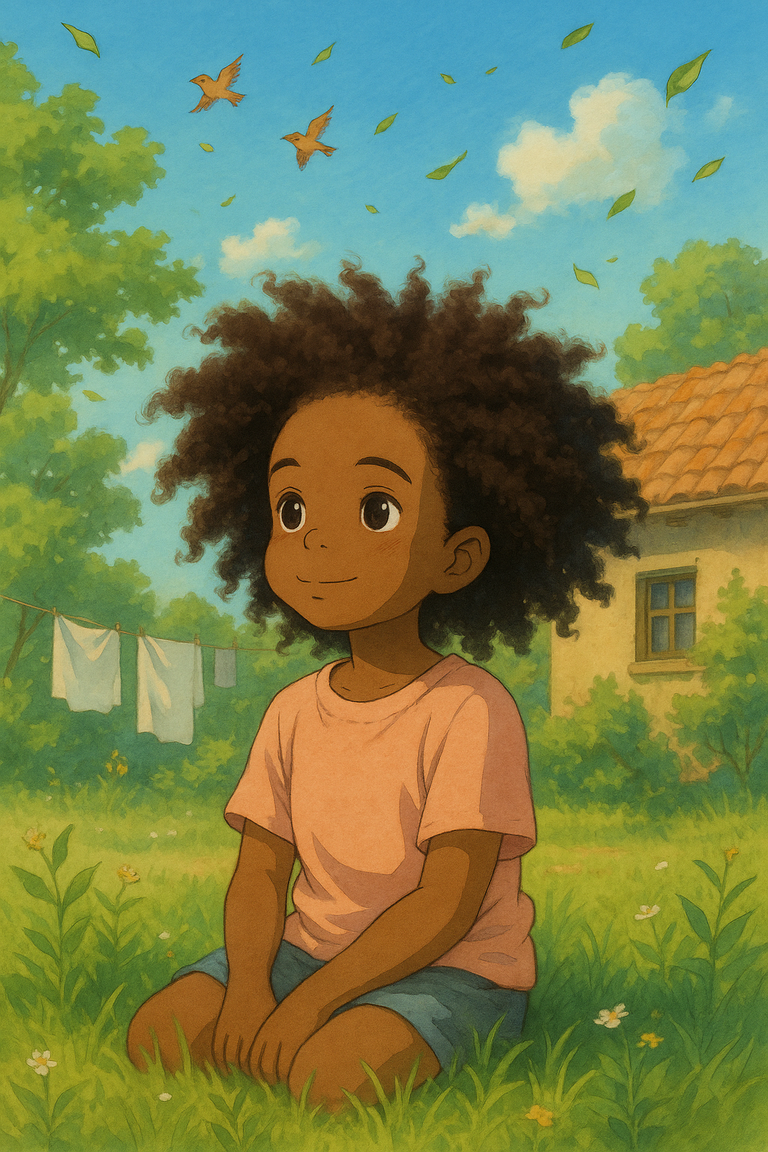
Letting the air do its work
There’s a wisdom in air that our habits sometimes forget. In a world that moves fast—where the hairdryer hums as soon as the shower ends, and towels scrub like regrets—air-drying our children’s hair becomes a quiet act of rebellion. A declaration of tenderness.
Afro hair, with its spiral structure, hates intense heat. It retracts, weakens, breaks. Using a hairdryer on fragile curls is like burning a letter before reading it: erasing a message entrusted by nature.
Air-drying, on the other hand, gives the hair time to breathe, to stretch, to define itself at its own pace. It also preserves the moisture added during previous care steps, prevents sudden evaporation, and keeps the softness.
But it’s more than just a care technique. Letting a child experience this moment without rush teaches them that their natural texture isn’t a problem to solve, but a process to embrace. It gives them space to be, not to hide, to exist without compromise.
Tip:
After rinsing out the conditioner or mask, gently press out excess water with your hands, then wrap your child’s head in a soft cloth for a few minutes. Let their hair dry naturally, in the shade, away from cold or direct wind.
Avoiding the classic towel
The most common—and quiet—mistake is the towel. That thick, rough one we instinctively wrap around the head, thinking we’re doing the right thing. But regular cotton fibers snag curls, lift cuticles, and cause what’s called mechanical breakage. Every rub is a micro-aggression.
This is especially true for children, whose hair is finer and more fragile.
So let’s change the rules. Ditch the standard towel. Choose microfiber: soft, smooth, absorbent without being harsh. Or better yet: a simple cotton T-shirt—worn, soft, clean—can work wonders. It respects the curl’s natural shape, absorbs water gently, and prevents frizz.
DIY tip:
Reserve an old long-sleeve T-shirt to turn into a “turban towel” used only for your child’s hair. Not only is it protective, it becomes a familiar object tied to moments of calm and care.
Detangling (between science, love, and patience)
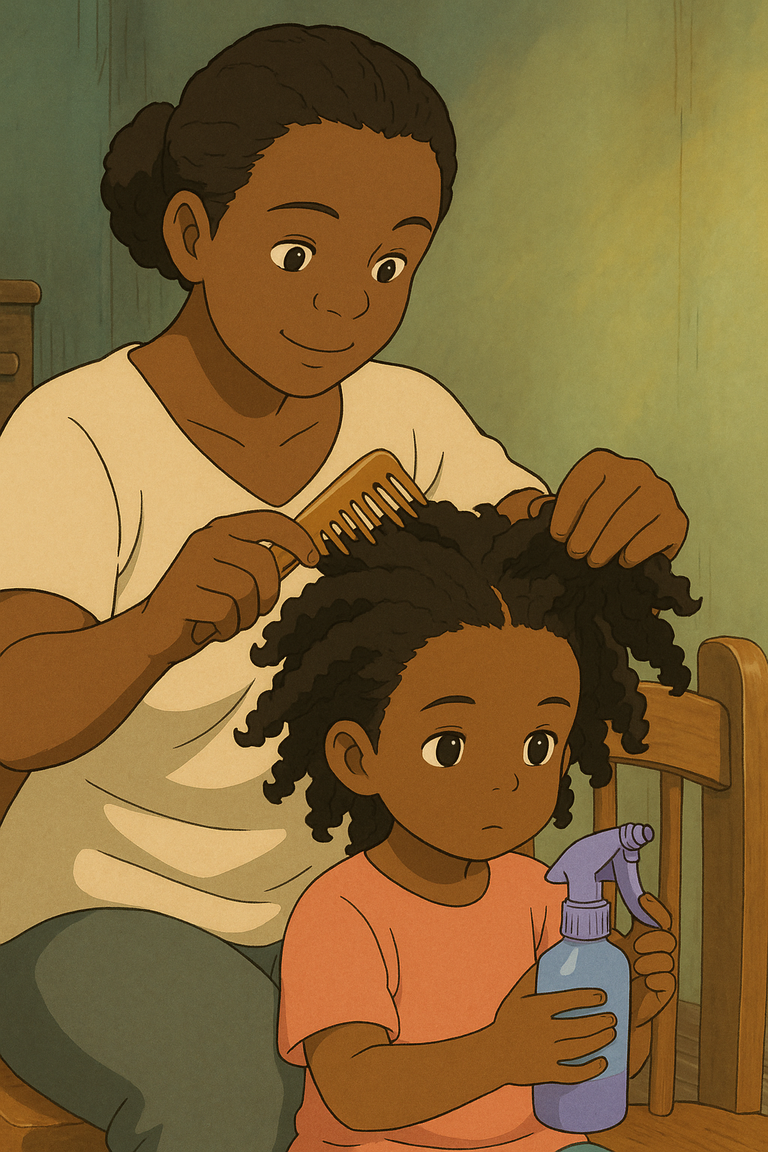
Detangling an Afro child’s hair is more than a grooming step—it’s a formative moment. It can build a bond or create distance. It can foster self-love or reopen old wounds. Every stroke of the comb carries a message. Better to make it say: “I love you, and I respect you.”
Mistakes to avoid
Too many parents, rushed or uninformed, repeat the pain they endured growing up. The ripping comb, the tears, the yelling, the hurry. But our little ones deserve more than inherited pain.
Here’s what to avoid:
- Detangling dry: Afro-textured hair needs moisture to become manageable. Dry, every knot becomes a battle.
- Starting from the roots: this tugs on the scalp unnecessarily, causing pain, breakage, and resistance.
- Skipping sections: without clear parting, hair gets more tangled, and the child grows impatient.
- Using fine-toothed combs: made for other textures, they don’t respect the density or structure of kinky hair.
- Rushing: haste causes hurt. And the child learns to dread the moment instead of seeing it as care.
Every mistake is a missed opportunity to build a healthy relationship with hair.
The ritual to adopt
Turning detangling into a ritual restores its proper role: an act of trust, transmission, and peace.
Here’s the protocol to follow:
- Start by misting: use a spray bottle filled with spring water, a light oil (jojoba or almond), and optionally, a few drops of liquid aloe vera. This helps fingers or comb glide through.
- Part into sections: four, six, eight—depending on the child’s age and hair density. It structures the process and reassures.
- Start with fingers: the toughest knots often unravel better by hand, pain-free.
- Follow with a wide-toothed comb, always working from tips to roots, slowly.
- Finish with a soft brush if needed, to gently smooth.
It’s not just about efficiency—it’s about respect. Afro hair, especially in children, deserves to be handled with intention, not urgency.
Finding the right moment
Hair care should be a moment of connection, not conflict. Choose a quiet time: after bath, before nap, during storytime. Play soft music, or create a verbal ritual: tell a legend, a family anecdote, an African fable while combing.
Because what the child will remember isn’t just how their hair was styled—but how they felt while it was being done. Respected or rushed. Heard or forced. This moment is a mirror of the relationship we are building with them.
Tip:
Name the spray bottle (“the magic potion”), invent characters around the knots (“the tangled trolls”), make it a game… so that hair care becomes a source of pride, not a chore.
Styling without breaking (creativity as inheritance)
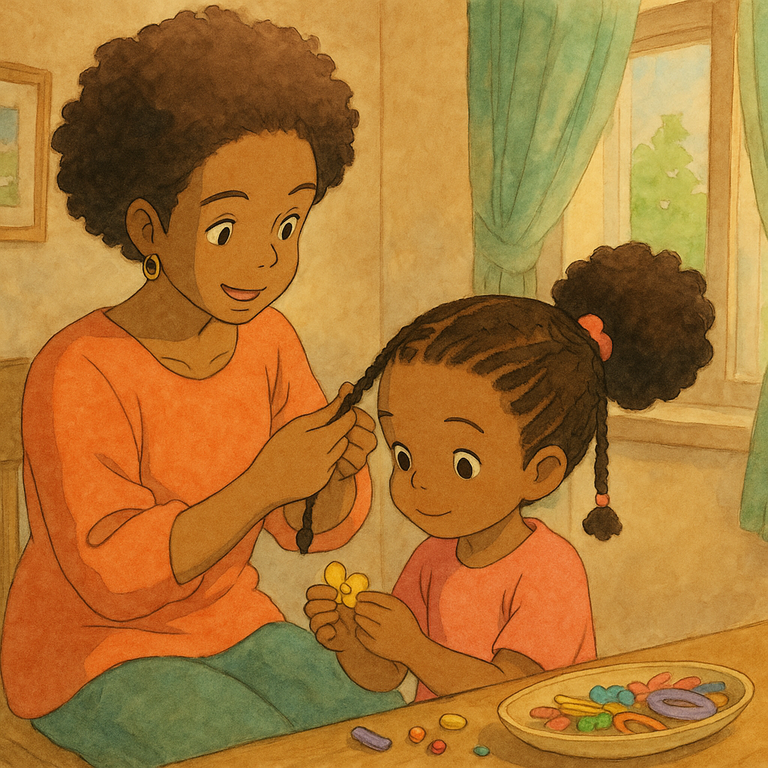
Styling a Black child’s hair is like engraving memory onto their head. It maps out what we pass on: pride or pain, beauty or shame, freedom or constraint. And too often, so-called “protective styles” have in reality been sources of tension—both literal and emotional.
But it’s time to change that. Time to make every braid an act of love. Every hairstyle, a celebration—not a resignation.
Say no to traumatic hairstyles
Let’s be clear: hair extensions have no place on the head of a young child. Their weight, their tightness, and the maintenance they require are not suited to fragile, developing hair. And beyond the scalp, they affect self-esteem—especially when, by age 3 or 4, a little girl is already being told her natural hair is “not enough.”
Tight hairstyles damage the temples (traction alopecia), irritate the scalp, and can lead to chronic headaches. Worse still, they plant the toxic idea that beauty requires pain—an inherited lie we must break free from.
Children need space. Air. The certainty that their hair, just as it is, is beautiful. Especially without embellishments.
Embrace simplicity
What if beauty lies in simplicity? Two twists. A few cornrows. A light, airy Afro puff. The lightest hairstyles often give children the most room to simply be… children. To move, run, dance, dream—without being restricted by a rigid style.
Simplicity doesn’t mean carelessness; it can be a form of subtle sophistication. All it takes is a little love: a well-chosen barrette, a satin ribbon, a gracefully tied scarf. The child then learns that their hair doesn’t need to be disguised to be admired.
Avoid:
- Tight, thin elastics
- Metal clips or sharp-edged barrettes
- Rough fabrics like raw cotton
Favor:
- Satin or silk scrunchies
- Soft plastic or wooden clips
- Wide headbands lined with silk
Because every accessory carries a message: “I protect you,” or “I restrain you.”
Encourage creativity
Afro hair is a blank canvas. And every child is a budding artist. Letting them choose their barrettes, their colors, their beads is giving them a first chance to say, “This is who I am.”
What seems like a simple choice is actually foundational. A child who helps with their hairstyle learns to take ownership of their appearance, to experiment, to love their reflection. They become the creator of their image—not just a receiver of imposed standards.
Create themes together: “butterfly day,” “rainbow vibes,” “ancestral beads.” Braid a story along with the hairstyle. Equip them for freedom, strand by strand.
Tip:
Make a “magic box” with metal-free accessories, soft scrunchies, and colorful clips. Let your child pick and compose their own hairstyle for the day.
Products to favor
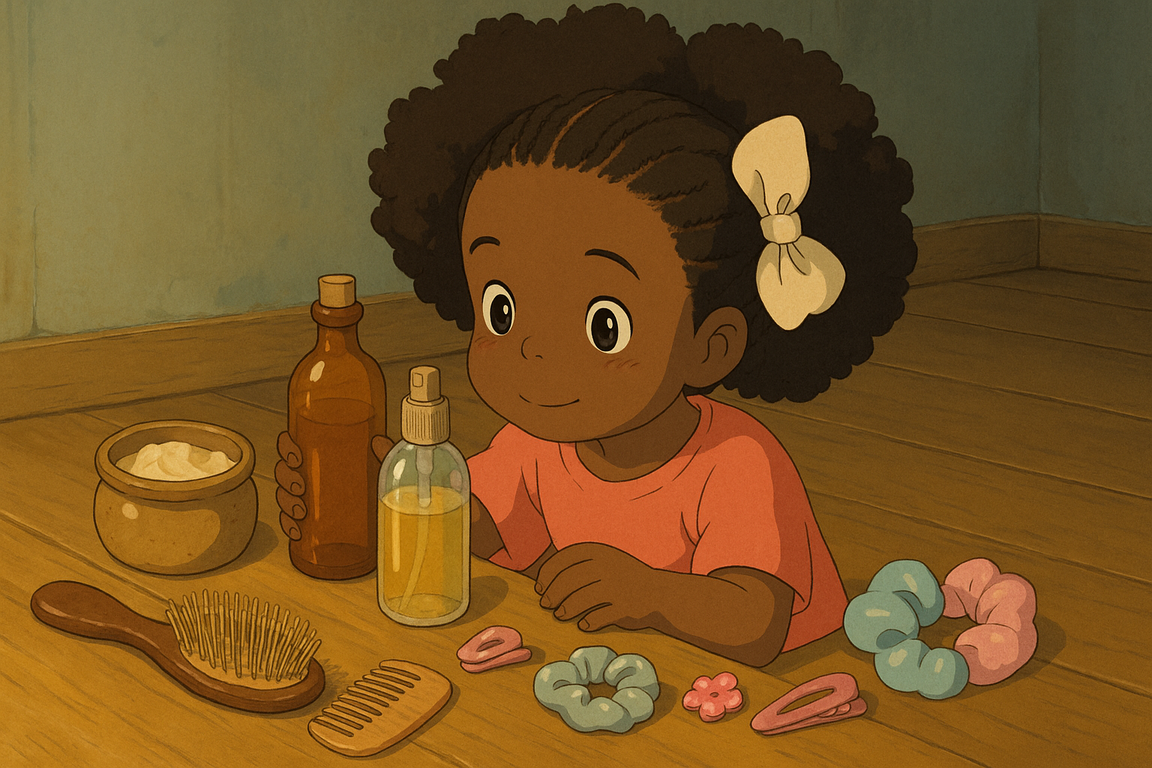
Finding the right products for Afro-descendant children’s hair is like finding the ingredients for a love potion. It’s not just about moisturizing or smoothing—it’s about protecting, nourishing, and honoring a texture that history has too often tried to erase.
In a market flooded with empty promises and artificial fragrances, we must return to the essentials. To the earth. To tradition. To what grandmothers knew long before it was called “clean beauty.” This return to the roots is the best way to offer our children healthy, lasting, and safe care for their delicate scalps.
Raw shea butter: The ancestral protector
It needs no introduction. Raw, unrefined shea butter is one of Africa’s most precious treasures. It deeply nourishes, seals in moisture, soothes irritation, and protects the ends of kinky hair from breakage.
Used in small amounts, it can be melted in your palms and applied section by section to damp or lightly misted hair. On ends, it acts as a natural shield. On the scalp, it heals and calms.
Tip:
Choose yellow or ivory shea with a natural nutty scent. Beware of overly white or deodorized versions—they’re usually over-processed.
Plant oils: Guardians of softness
Each vegetable oil is a treasure—if chosen wisely:
- Jojoba oil: closest to natural sebum, perfect for scalp balance.
- Coconut oil: light, penetrating, protects without heaviness—great for summer.
- Sweet almond oil: soothing, nourishing, perfect for gentle massages.
- Castor oil: deeply nourishing, to be used in moderation and blended with lighter oils (jojoba or coconut), especially on thinning areas.
These oils can be used as pre-shampoo oil baths or in spray bottles for daily hydration.
The magic spray bottle: Water + oil + love
A well-made spray bottle is a kinky child’s best friend. It hydrates without soaking, refreshes curls, and eases detangling painlessly.
🌸 Simple recipe:
- 2/3 spring water or chamomile hydrosol
- 1/3 light plant oil (jojoba or almond)
- A few drops of liquid aloe vera (optional)
Use it morning and night—or before any styling.
Gentle shampoos: Cleanse without stripping
A child’s scalp cannot handle harsh washing. Favor very gentle cleansing bases: diluted African black soap, rhassoul clay, or shampoos free from sulfates, silicones, and alcohol.
The goal: clean without removing natural protection. If the shampoo lathers too much, that’s often a bad sign.
🧴 Tip:
Dilute shampoo in a bit of warm water before applying to avoid over-concentration on the scalp.
The right tools: respect the curl
Forget hard brushes and fine combs. To protect our little ones’ hair:
- Wide-toothed comb: ideal for detangling without breakage
- Soft round brush (e.g., vegan boar bristle): for gentle smoothing
- Fingers first: nothing beats hands for soft, knot-free detangling
The right accessories: No metal, no pain
Even a simple accessory can cause damage if poorly chosen. Metal snags, cotton dries out, tight elastics snap hair.
Best choices:
- Satin-covered elastics
- Silk or microfiber scrunchies
- Metal-free clips
- Flat, soft plastic pins
Let’s remember: children’s hair is also sensitive antennae. Accessories should be as gentle as the hands that use them.pagnent.
Passing down more than a routine: A culture, a confidence
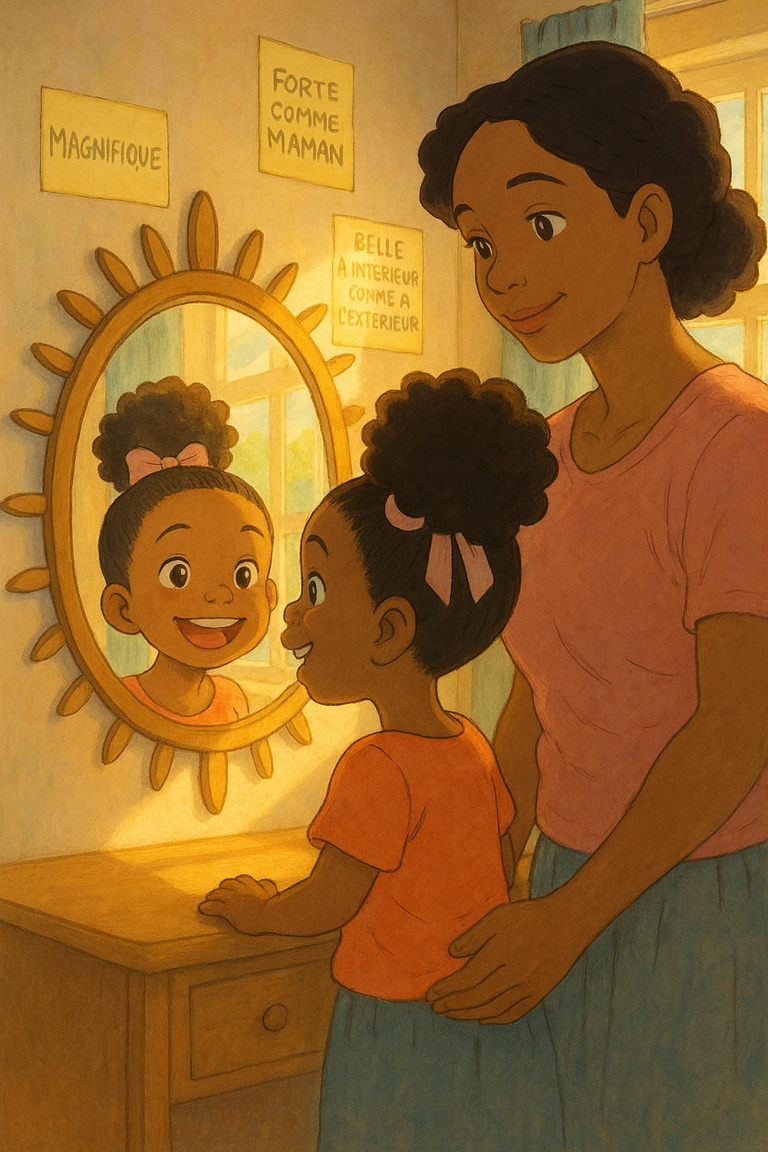
Doing your child’s hair isn’t just another chore in a busy day. It’s an act of grounding. A quiet but profound way of saying: “You belong, just as you are.” Behind every curl, every knot gently undone, every carefully placed braid, lies a world of symbols. A living memory. And a future to rewrite.
The power of the mirror
It starts with the gaze. Not the one society casts on our children—but the one they learn to cast on themselves.
A child who sees their mother love her own kinky hair, her own features, her unfiltered reflection, learns to love their own. They soak in that gentleness like an invisible elixir. They realize that what they were sometimes told was a “problem” (their hair, their texture, their density) is actually a treasure to celebrate.
The mirror becomes more than a glass—it becomes a witness. A witness to self-love passed down through example, through gesture, through the quiet between two twists or the song hummed during detangling.
It’s not just a hair routine. It’s an education in self-worth. A backward inheritance—healing past generations while lifting up the next.
Hair as affirmation
For centuries, our hair was controlled, denied, hidden—in pain, in silence, in shame.
Today, by caring for our children’s hair with patience, pride, and tenderness, we break that chain. We turn hair care into a political, emotional, and aesthetic affirmation.
Rejecting Eurocentric beauty standards doesn’t always require a speech. Sometimes, it starts with a gentle hand. A style without strain. A tearless moment. A whispered compliment in the mirror:
“You are beautiful. Just like this.”
And that’s enough. Because that child, nourished by that look, will remember it forever. They’ll grow up knowing they have nothing to straighten, nothing to hide, nothing to erase to be worthy of love, dignity, or beauty.
✊🏾 Caring for our little ones’ hair is a slow, intimate reconciliation with our past. It’s choosing the caress over the struggle. It’s nurturing, strand by strand, the freedom to be oneself.
From root to crown
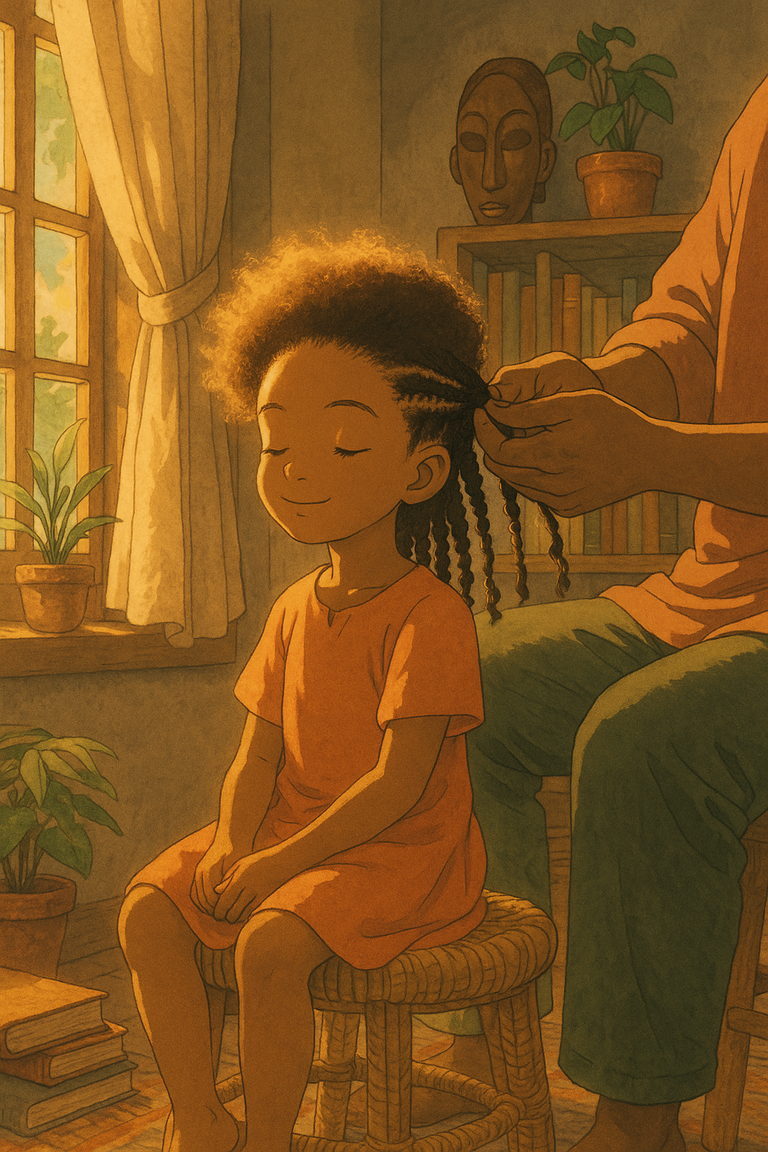
Caring for our children’s hair is no ordinary act. It’s repairing old silences, healing rough gestures of the past, and passing down to our kids the idea that they have nothing to change to be beautiful. Nothing to straighten to be accepted. Nothing to hide to be seen.
To all those who braid love into their children’s hair each morning:
You are the guardians of a kingdom. Keep going.
Table of Contents
- Inheriting the Crown
- Understanding Our Children’s Hair
- The Unique Structure of Afro Hair
- The Importance of the Scalp
- The Truth About Shampoo (What No One Tells You)
- Less Is More
- The Magic of Gentle Conditioners
- The Art of Drying
- Letting the Air Do Its Work
- Avoiding the Classic Towel
- Detangling (Between Science, Love, and Patience)
- Mistakes to Avoid
- The Ritual to Adopt
- The Right Moment
- Styling Without Breaking (Creativity as Inheritance)
- Say No to Traumatic Hairstyles
- Embrace Simplicity
- Encourage Creativity
- Products to Favor
- Raw Shea Butter: The Ancestral Protector
- Plant Oils: Guardians of Softness
- The Magic Spray Bottle: Water + Oil + Love
- Gentle Shampoos: Cleanse Without Stripping
- The Right Tools: Respect the Curl
- The Right Accessories: No Metal, No Pain
- Passing Down More Than a Routine: A Culture, A Confidence
- The Power of the Mirror
- Hair as Affirmation
- From Root to Crown
